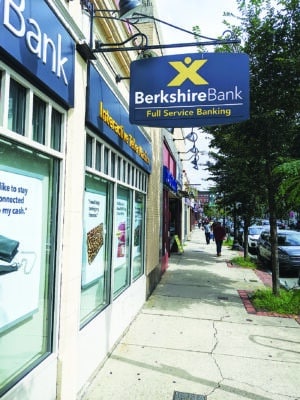
A Berkshire Bank storefront branch in Boston’s Brighton neighborhood. The bank is twinning a major small business lending push with updates to its banking services. Photo by James Sanna | Banker & Tradesman Staff
A new three-year environmental, social and governance commitment by Boston-based Berkshire Bank will bring billions of dollars in lending to the bank’s New England and New York footprint, including $1.5 billion targeted at small businesses.
“Even while I absolutely believe that the PPP was incredibly powerful in helping retain some of those businesses and their employees on the payroll, [the pandemic] still had a significant amount of casualties on the number of businesses that were operating, and many of them would be hesitant to get back,” said Berkshire Bank CEO Nitin Mhatre. “We believe that part of our mission is to help some of the new businesses get started again or some of the old businesses get restarted again.”
Even as the economy improves, the effects of the pandemic have left small businesses with funding, technical and other needs that will be critical to their long-term success.
“These are very difficult times for the small business community in Massachusetts,” said Alison Moronta, director of economic development for Dorchester Bay Economic Development Corp. “They have been impacted in a way beyond our imagination. …They need more resources.”
Complexities Cloud Picture
While small businesses still need capital for the same reasons that they did before the pandemic, they also face new costs and complexities, said Samalid Hogan, the regional director of the Massachusetts Small Business Development Center Network’s Western Regional Office.
Businesses from restaurants to yoga studios got creative in how they adapted their operations, Hogan said, requiring additional spending on new equipment and website development, as well as marketing strategies to reach customers.
Other businesses in Western Massachusetts have sought U.S. Small Business Administration 504 loans to purchase equipment or buy office space while rates remain low in order to reduce monthly expenses and to purchase equipment, Hogan said. Other businesses have needed financing for working capital.
While small businesses are experiencing the same worker shortages affecting industries across the state, Hogan said business owners expect to see improvements toward the winter months.
“We hope we will be better positioned for a stronger 2022 for small businesses,” Hogan said.
Technical assistance for small businesses and proactive outreach are also needed to ensure business owners learn about and understand grant and lending opportunities available to them, said Dorchester Bay’s Moronta, which as a community development financial institution provides SBA microlending in six Boston neighborhoods.
Dorchester Bay is creating new loan products, Moronta said, including a resiliency product that will provide cash flow to businesses, offering flexible terms and accepting lower credit scores.
There are gaps in services to business owners in immigrant and minority communities, Moronta said, noting that while entrepreneurs are resilient, they sometimes attempt to manage difficulties on their own. Because community development corporations and CDFIs are already connected with the local business community, Moronta said, funding for these institutions are critical to help fill these gaps.
“This is the real time for the entire community to come together and help the businesses in all different ways,” Moronta said. “There is a responsibility in many ways because they are taxpayers, they are the backbone of the economy.”
ESG and Service Improvements
Berkshire Bank’s $1.5 billion lending commitment to small businesses is part of a three-year, $5 billion initiative the bank is calling “BEST Community Comeback.” The initiative is tied to the bank’s BEST (Berkshire’s Exciting Strategic Transformation) strategy, which the bank launched in May following a 10-month period that began with significant financial losses and the resignation of then-CEO Richard Marotta.
When Berkshire Bank rolled out the BEST plan, Mhatre said, the goal was to amplify the bank’s purpose while improving performance, including return on equity, return on assets and pre-tax revenue. The bank also wanted to improve its ESG ratings measured by third parties, targeting a place among the top 25 percent of banks in the country.
The three-year lending initiative will begin in 2022 and also includes $2.5 billion for mortgages, as well as targets for lending in low- and moderate-income neighborhoods, a significant part of the bank’s predominantly rural and semi-urban footprint, Mhatre said.
In addition to providing lending, Berkshire Bank also plans to improve the experience for small business owners by digitizing more banking services, establishing additional fintech partnerships and hiring more bankers in customer-facing roles. Berkshire has already started hiring for these roles, Mhatre said, and will continue adding staff to support the bank’s lending commitment over the next four to five quarters.
Gary Levante, Berkshire Bank’s senior vice president of corporate responsibility and culture, said hiring a workforce that is representative of the communities the bank works with is part of the strategy.
Bank to Strengthen Partnerships
To reach new small business customers, the bank will also look to strengthen relationships with community organizations, including CDFIs, that work on the frontlines with businesses, Levante said.

Diane McLaughlin
“It’s the financing and everything that we’re doing to make that process more efficient and more effective – get that capital out,” Levante said. “It’s also the programmatic side – how we leverage our expertise and our partnerships with the community to make sure we’re setting up businesses to thrive and be successful.”
With mergers and acquisitions transforming the region’s banking industry this year, Mhatre said Berkshire Bank will have opportunities to work with customers that might feel disenfranchised as their current institution becomes bigger.
“We will differentiate ourselves through programs like this as well as having more bankers on the ground that are going to reflect our purpose and mission better than our competitors can,” Mhatre said.





